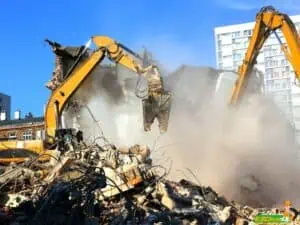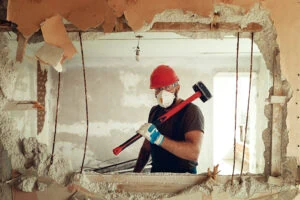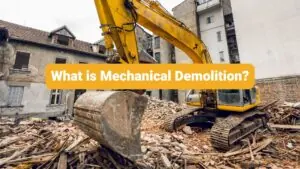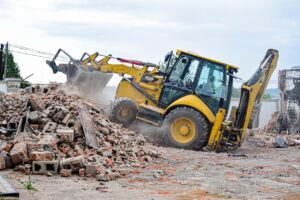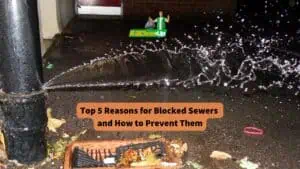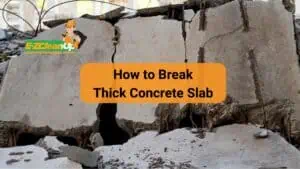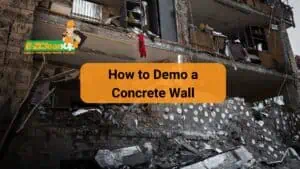Demolition is a fascinating and complex field that involves much more than simply tearing down buildings. It’s a carefully planned and executed process that requires a deep understanding of structures, materials, and the forces that can be used to bring them down.
Two of the most common techniques used in the demolition industry are explosion and implosion.
While they might sound similar, they are fundamentally different in their approach and application. In this article, we will delve into the world of demolition, exploring the intricacies of explosion and implosion, their advantages and disadvantages, and the situations where each technique is most effectively used.
So, whether you’re a professional in the industry, a curious reader, or someone considering a demolition project, read on to gain a deeper understanding of these powerful techniques.
Defining the Terms: Explosion vs. Implosion 💥
Before we delve into the specifics, let’s first define what we mean by explosion and implosion in the context of demolition.
Explosion is a process that involves the rapid release of energy in an outward direction. In demolition, this is typically achieved through the use of explosives. The force of the explosion is used to break apart the structure, causing it to collapse.
On the other hand, implosion is a process where a structure is made to collapse inward, onto itself. This is achieved by strategically weakening or removing certain support structures within the building and using gravity to bring the building down. While explosives can also be used in implosion, the key difference lies in the direction of the force and the strategic planning involved.

Understanding Explosion: The Outward Force 🧨
Explosions in demolition work by using the force of explosives to break apart a structure. The explosives are typically placed at strategic points within the structure, and when detonated, they create a powerful outward force. This force is strong enough to break apart the materials that make up the building, causing it to collapse. The process is quick and powerful, making explosion a popular choice for demolishing large structures.
The Mechanics of Implosion: An Inward Collapse 🏢
Implosion, on the other hand, is a more controlled process. It involves strategically weakening or removing certain support structures within a building. When these supports are removed, the building can no longer stand, and it collapses inward, onto itself. This is often achieved through the use of explosives, but unlike in an explosion, the explosives are used in a very controlled and strategic manner. The goal is to direct the force of the explosion inward, causing the building to collapse onto itself, rather than exploding outward. This makes implosion a popular choice for demolitions in urban settings, where controlling the collapse of the building is crucial to minimize damage to surrounding structures.
Explosion & Implosion in Demolition: A Closer Look 💣
Understanding the principles of explosion and implosion is one thing, but how are these techniques applied in the field of demolition? Let’s take a closer look.
Explosion in Demolition: Unleashing the Power 💥
Mechanism of Explosion
In the context of demolition, an explosion is a process that uses the rapid release of energy to break apart and destroy a structure. The energy is released outward, creating a powerful force that can shatter concrete, bend steel, and reduce a building to rubble in a matter of seconds.
Application of Explosive Force Outward
The key to successful demolition using explosives is the strategic placement of explosives. The explosives are typically placed in drilled holes within the structure and are detonated simultaneously to ensure the entire structure collapses at once. The force of the explosion is directed outward, breaking apart the structure and causing it to collapse.
Types of Explosives Used
The types of explosives used in demolition can vary, but they typically include high velocity explosives such as C4, dynamite, or other types of plastic explosives. These explosives are chosen for their ability to deliver a powerful and instantaneous shock wave, which is necessary to shatter and displace the materials of the structure.
Situations Where Explosion is Used
An explosion is typically used in situations where a structure needs to be demolished quickly and efficiently. This might include the demolition of large structures like bridges, towers, or large commercial buildings.
It’s also commonly used in situations where other methods of demolition might be impractical or time-consuming. However, due to the uncontrolled nature of the explosion, this method is less suitable for urban settings or areas where collateral damage needs to be minimized.
Advantages of Explosion in Demolition 🚀
Explosion as a demolition technique comes with several advantages that make it a preferred choice in certain scenarios:
Speed ⏱️
One of the most significant advantages of using explosion in demolition is the speed at which a structure can be brought down. Once the explosives are placed and detonated, a building can be reduced to rubble in a matter of seconds. This makes explosion an excellent choice for projects that are on a tight schedule or where quick demolition is a priority.

Effectiveness in Certain Scenarios 🎯
An explosion is particularly effective in scenarios where the structure to be demolished is large, sturdy, or complex. The powerful force of the explosion can easily break apart and displace the materials of the structure, making it an effective method for demolishing large buildings, bridges, towers, and other substantial structures. It’s also useful in situations where other methods of demolition might be impractical.
Disadvantages of Explosion in Demolition 💣
While explosion can be an effective demolition technique, it also comes with several disadvantages that need to be considered:
Safety Risks ⚠️
Explosions, by their very nature, can be dangerous. There’s always a risk of flying debris, which can pose a significant safety hazard to both the demolition crew and the general public. Strict safety measures and exclusion zones need to be established to mitigate these risks.
Collateral Damage 🏚️
The force of an explosion is hard to contain, and there’s always a risk of collateral damage to nearby structures. This makes explosion less suitable for urban settings or areas where there are other buildings close by.
Noise Pollution 🔊
Explosions are loud, and the noise can be disruptive, especially in populated areas. Noise pollution regulations may limit the use of explosives in certain areas or at certain times.
Environmental Impact 🌍
Explosions can generate a significant amount of dust and debris, which can have a negative impact on the local environment. Additionally, the explosives used can sometimes release harmful substances into the environment. Proper cleanup and disposal of debris are essential to mitigate these environmental impacts.
Unpredictability 🎲
Explosions can be somewhat unpredictable. Small variations in the structure or the explosives used can result in the building collapsing in an unexpected way, which adds an element of risk to the process.
Implosion in Demolition: A Controlled Collapse 🏗️
Mechanism of Implosion
Implosion in demolition is a highly controlled process that involves weakening a structure so that it collapses inward onto itself. This is achieved by strategically removing or weakening certain support structures within the building. When these supports are removed, the building can no longer stand, and it collapses inward, under the force of gravity.
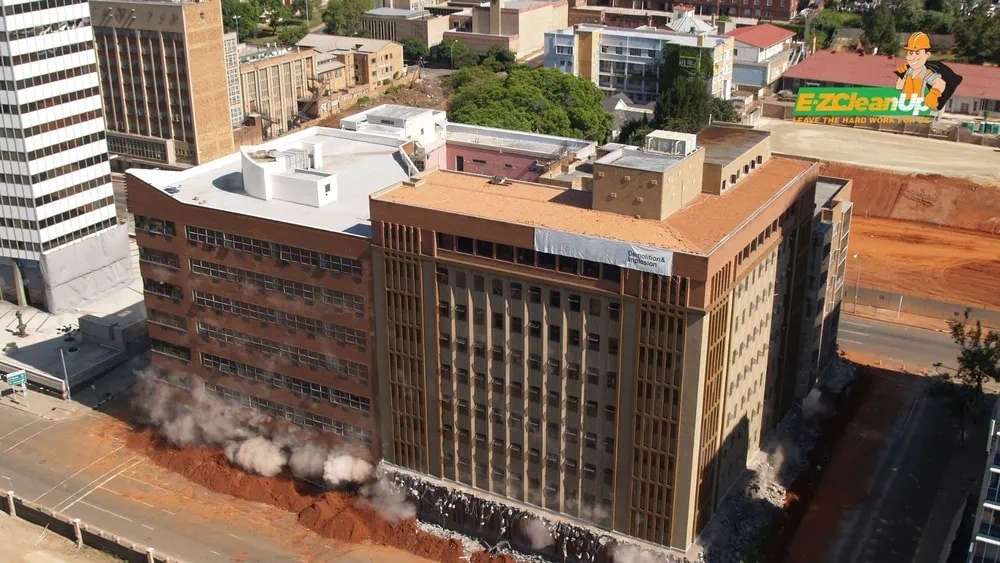
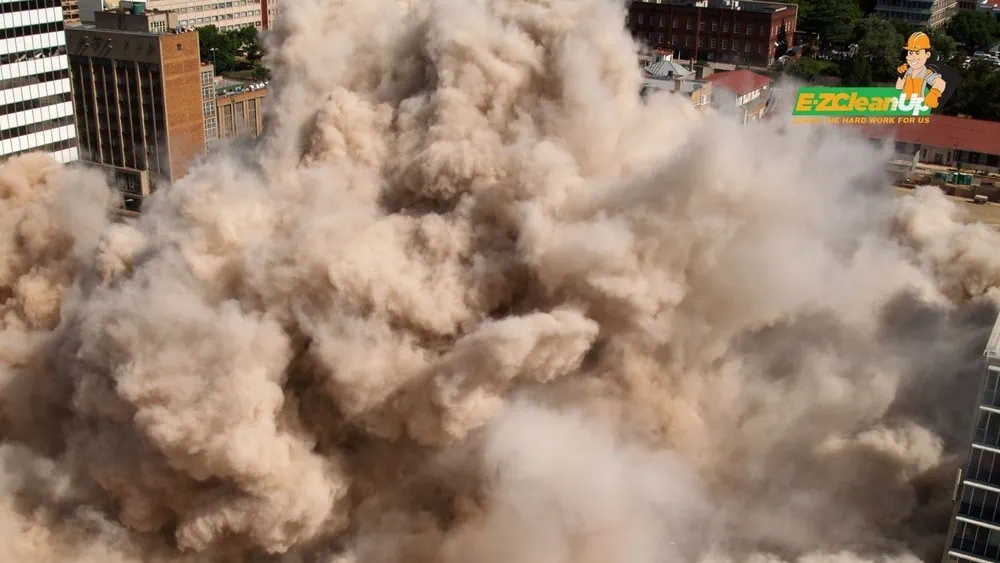

Weakening a Structure to Collapse Inward
The key to successful implosion is the strategic weakening of the structure. This often involves identifying the main support structures within the building and placing explosives at these points. The explosives are then detonated in a specific sequence, which causes the building to collapse inward, onto itself.
Types of Explosives Used
Like explosion, implosion also often involves the use of high velocity explosives such as dynamite or C4. However, the explosives are used in a much more controlled and strategic manner. The goal is not to destroy the building with the force of the explosion, but rather to use the explosion to remove key supports, causing the building to collapse under its own weight.
Situations Where Implosion is Used
Implosion is often used in urban settings, where buildings are close together and there is a need to minimize damage to surrounding structures. It’s also used when the structure to be demolished is very large or complex, and other methods of demolition would be impractical. However, implosion requires a high level of expertise and careful planning, making it a more complex and often more costly method of demolition.
Advantages of Implosion in Demolition 🏢
Implosion as a demolition technique has several advantages that make it a preferred choice in certain situations:
Controlled Demolition 🎛️
Implosion is a highly controlled process. By strategically placing and detonating explosives, demolition experts can control which parts of the building collapse and in what order. This allows for a high degree of control over the demolition process and the final outcome.
Minimal Collateral Damage 🏘️
Because implosion causes a building to collapse inward onto itself, it minimizes the risk of damage to surrounding structures. This makes implosion a good choice for urban settings or areas where there are other buildings close by.
Suitable for Urban Settings 🌆
Implosion is particularly suitable for urban settings. The controlled nature of the implosion process means that buildings can be demolished with minimal impact on surrounding structures and infrastructure.
Disadvantages of Implosion in Demolition 🚧
While implosion has its advantages, it also comes with several disadvantages:
Complex Planning and Preparation 📝
Implosion requires a high level of expertise and careful planning. Each implosion is unique and requires a detailed understanding of the structure’s design and materials. This can make the planning and preparation process for implosion more complex and time-consuming than for other methods of demolition.
Explosion vs. Implosion: A Comparative Overview
While both explosion and implosion are effective demolition techniques, they each have their strengths and weaknesses. Here’s a comparative overview of the two methods:
| Explosion | Implosion | |
| Control Over the Process | Less control due to the outward force of the explosion. | High degree of control due to the inward collapse of the structure. |
| Risks | Higher risk of collateral damage and safety hazards due to the uncontrolled nature of the explosion. | Risks are generally lower due to the controlled nature of the implosion, but unpredictability can still pose challenges. |
| Effectiveness | Highly effective for large, sturdy structures where quick demolition is required. | Highly effective in urban settings or where minimal impact on surrounding structures is required. |
It’s important to note that the choice between explosion and implosion will depend on a variety of factors, including the specific characteristics of the structure, the surrounding environment, and the goals of the demolition project. A professional demolition company like EZ CleanUp can provide expert advice on the best approach for each unique situation.
Famous Demolitions and Their Techniques 🏙️
The world of demolition has seen some truly remarkable feats over the years. Here are two famous cases where implosion techniques were used:
The Kingdome, Seattle (Implosion): The Kingdome was a multi-purpose stadium in Seattle, Washington. When it was demolished in 2000, it was the largest structure ever imploded. The implosion was meticulously planned to ensure the structure fell inward and didn’t damage nearby buildings. The Kingdome was reduced to rubble in less than 20 seconds, making it a textbook example of a successful implosion.
The J.L. Hudson Department Store, Detroit (Implosion): The J.L. Hudson Department Store in Detroit was once the tallest department store in the world. When it was demolished in 1998, it was the tallest steel structure ever imploded. The demolition required careful planning to ensure the structure fell inward and didn’t damage the nearby Detroit People Mover track.
These examples highlight the power and precision of modern demolition techniques. These structures were brought down safely and efficiently, showcasing the expertise and planning that goes into each demolition project.
Conclusion 🚧
In the world of demolition, understanding the techniques of explosion and implosion is crucial. While both methods have their advantages and disadvantages, the choice between the two often depends on the specific characteristics of the structure and the surrounding environment.
However, regardless of the technique used, successful demolition requires careful planning, expertise, and a deep understanding of structures and materials. That’s where EZ CleanUp comes in. As a full-service junk removal and demolition company, we have the expertise and experience to handle all types of demolition projects, whether they require explosion, implosion, soft demolition, or other techniques.
Ready to start your demolition project? Trust the experts at EZ CleanUp to get the job done safely, efficiently, and professionally. Contact us today at (215) 678-2040 to learn more about our services and schedule your demolition!


